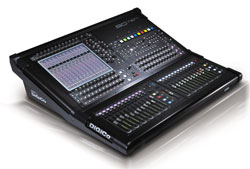
Dynamic EQ provides both expansion and compression on all four bands of parametric EQ.
These processors can be assigned to any of the input or output channels, whether stereo or LCR, with ten units being allocated as required.
In addition, any input or output channel can be mastered via the multi-band compressors – good for managing complex in ear monitoring or difficult input channels – and again, 10 units can be allocated.
Forty-eight (48) assignable buses can be configured as mono or stereo groups, or auxiliary buses. There is also an additional stereo or LCR Master bus and 16×12 output matrix, highlighting the SD range’s routing flexibility. Meanwhile, dual solo buses give monitor engineers the comfort of accurate monitoring security.
Insertable FX and graphic EQs can be routed, controlled and snapshot recalled for the most complex show design. The 24 graphics can easily be inserted and controlled from the worksurface and 10 Stealth stereo FX units can be configured at any time from the palette of thirty-three Stealth FX. Integration with Waves plug-ins offers yet more processing options.
Unlike all other Sound Grid platforms, DiGiCo provides complete control of plug in parameters, as well as recall of snapshots and single loading / saving, directly from the worksurface. Sixteen (16) stereo Sound Grid racks can be inserted, with up to eight plug-ins in each rack.
The SD10-24 software runs on a standard PC or Intel-based Macintosh for offline preparation and remote control of the console.
One SD10-24 can also be linked to another, using a standard Cat-5 crossover cable, providing 50 faders for control. In this configuration, the audio engine of the first SD Ten provides complete redundancy for the other.
The SD10-24 offers even more expansion options:
• Second-generation Optocore optic connections. Just like the SD7, an SD Ten can connect to up to 14 SD, MINI, NANO or D-Rack IDs with 448 audio channels on a single redundant optical loop.
• Five redundant consoles can share all inputs from the stage racks, and outputs on the system can be assigned in blocks of eight. For example, a single rack can provide 56 inputs to both consoles with 40 of the outputs assigned to the monitor console and 16 used by Front of House for feeds back to the stage.
• One console can even directly route outputs to another console on the loop, for convenient tie lines.
• D-Rack, SD-Rack, MINI-Rack, NANO-Rack, SD7, SD Ten and SD10-24 can operate together at 96 kHz. The audio advantage here is clear, but also means just over 1ms of latency when routing a stage input through a channel and buss, with processing back to a stage output.
• Sound Grid Waves can be added, allowing full connection and control of a Waves Sound Grid, providing low latency plugins on a floating point digital console.
• Connectivity to the outside world isn’t restricted to just the DiGiCo rack family. The SD Ten comes with different I/O options because tailored DiGiCo systems and complex set ups are completely user configurable.
• Dual hot swap, switch mode, PSUs as standard.
